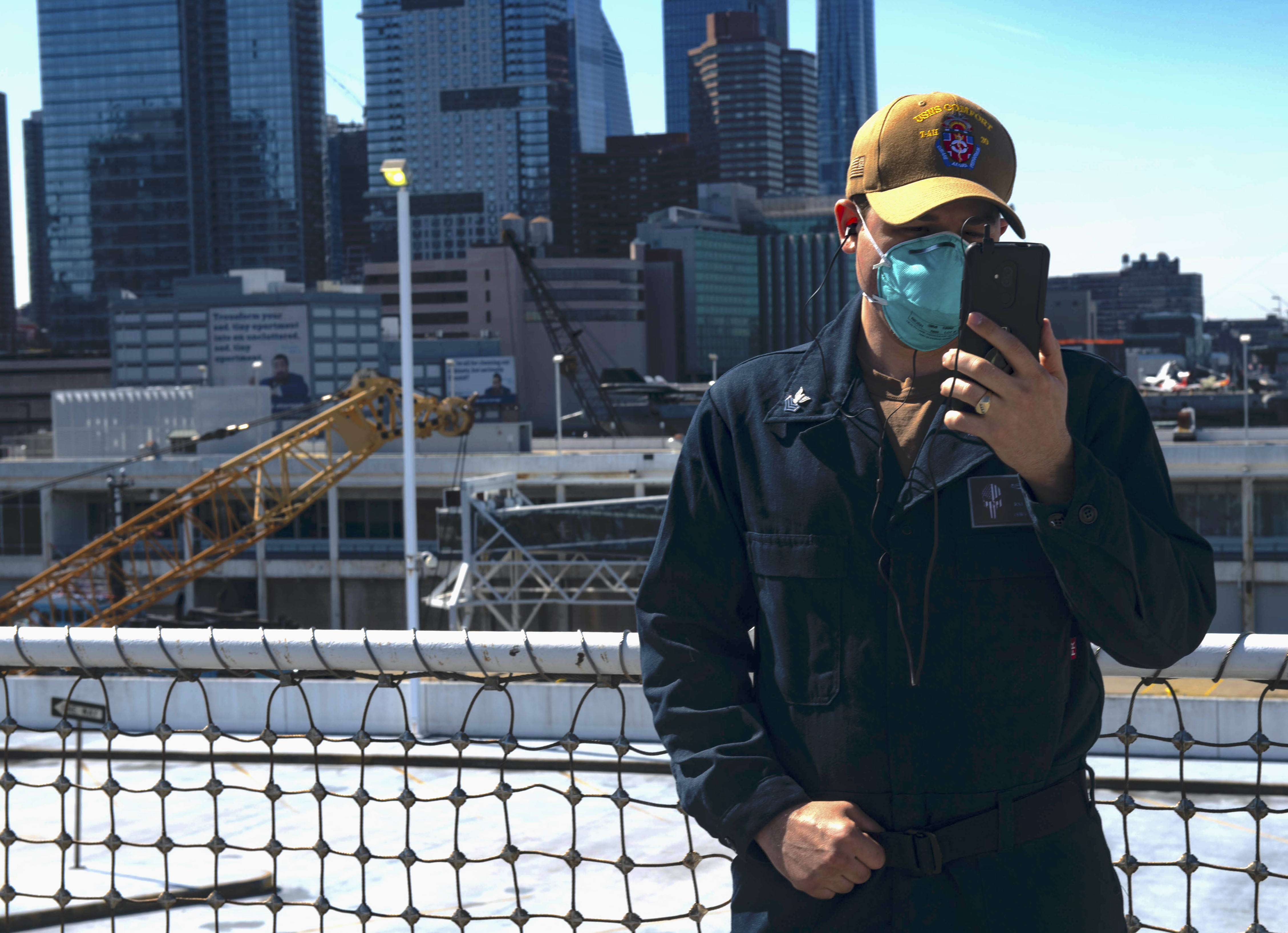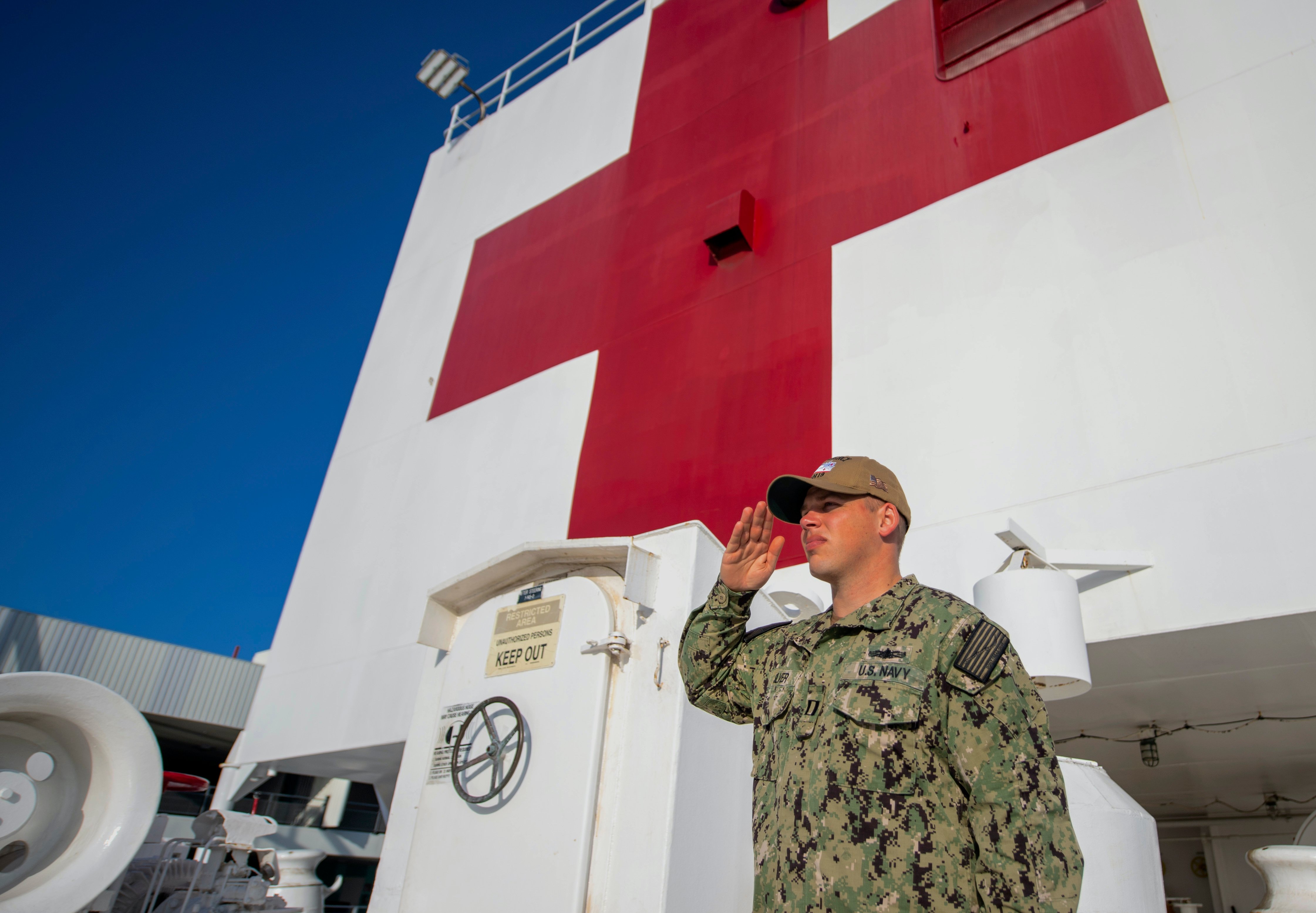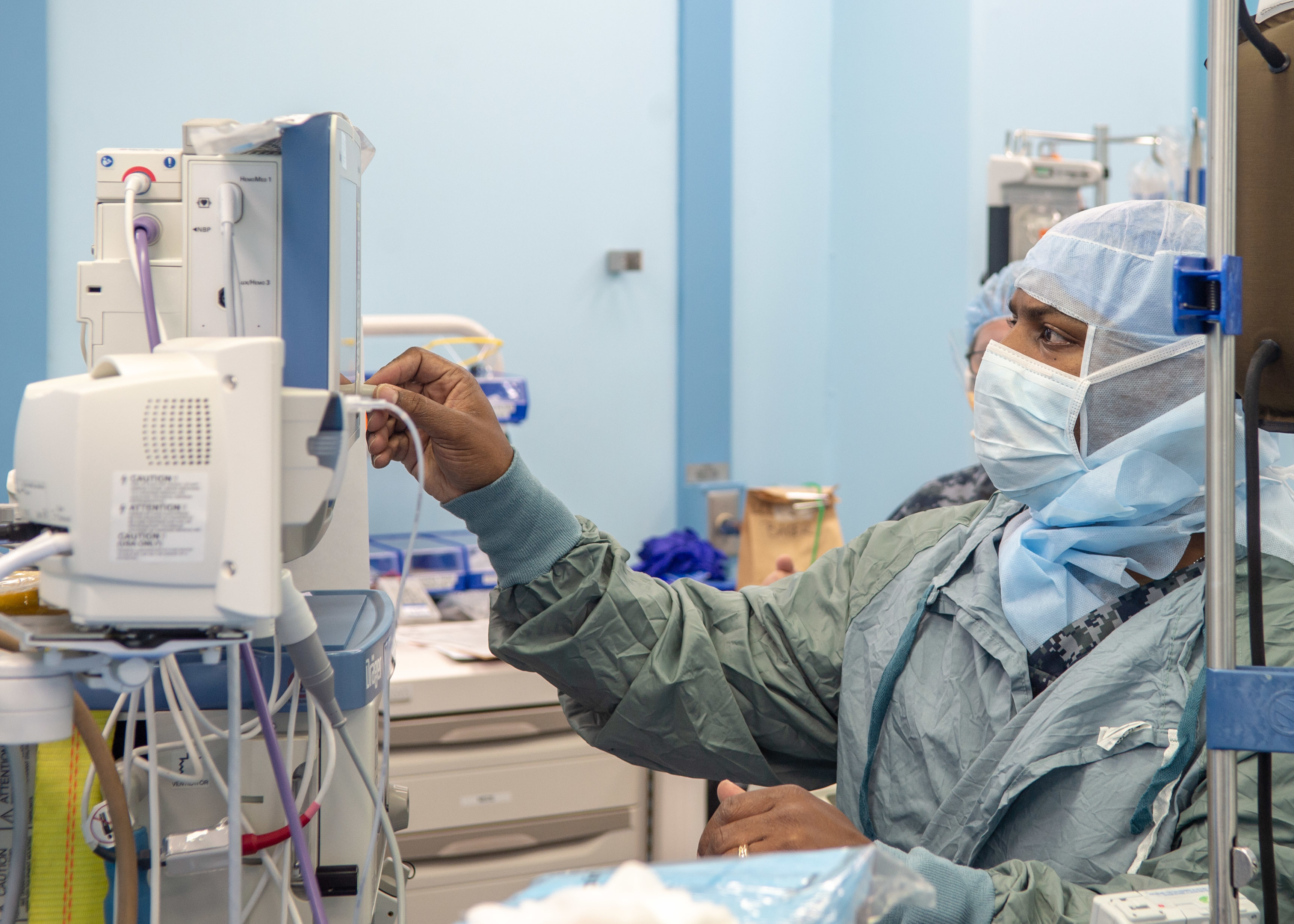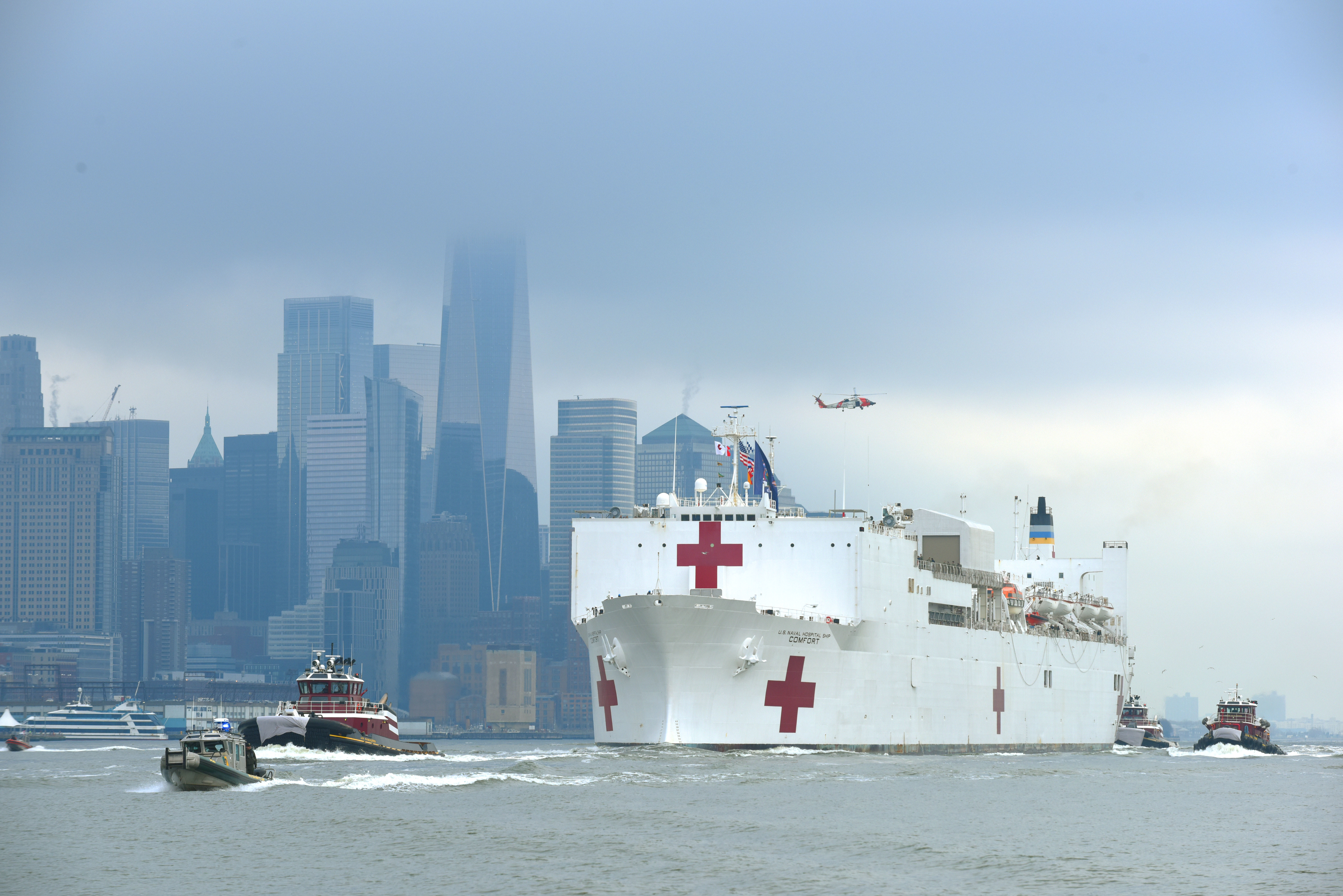
When orders came last month to deploy its two hospital ships to support the domestic COVID-19 response, Naval Information Warfare Systems Command scrambled teams of fleet systems engineers to upgrade both ships’ communications and network links for pier-side operations.
The result of that quick-turnaround, enterprise-supported assignment: Electronic health records, patient transfers, blood and medical supply inventories are received, shared, tracked and transmitted quickly via new fiber optic cable connections and upgraded IT software and improving coordination among the ships’ medical personnel and local civilian health providers in New York City and Los Angeles.
Hospital ships USNS Mercy (T-AH-19) and USNS Comfort (T-AH-20) have supported various domestic contingencies and biannual overseas missions in the Pacific and Atlantic regions for 30-plus years. The former San Clemente-class supertankers built in the 1970s to haul oil were overhauled a decade later into 1,000-bed hospitals with operating rooms, laboratories, pharmacy and room to accommodate an 800-plus medical treatment facility staff.
But the coronavirus support mission revealed shortfalls in the Military Sealift Command-operated ships’ bandwidth capacity and connectivity, including pier-to-ship connections both ships needed at the New York City and Los Angeles ports.

The Navy “wanted to make sure that when they pulled in, they have a good, solid network connection through, ideally, fiber optics,” said Mike Winslow, head of tactical networks division in the communications and networks department at Naval Information Warfare Center Pacific in San Diego. The Tactical Networks Program Office at NAVWAR headquarters, which runs the Base Level Information Infrastructure Piers program, coordinated with MSC, commercial providers and Defense Information Systems Agency “to get pier-side connectivity – essentially, fiber to the piers where the two ships were pulling in.”
Mercy was in ROS-5, or reduced operating status 5, at Naval Base San Diego, Calif., preparing for some maintenance when activation orders came in mid-March to get underway and support the coronavirus mission on the West Coast. Comfort was in Norfolk, Va., undergoing maintenance that was cut short with the orders to New York City.
Both ships got underway and berthed at the cities’ cruise ship terminals in late March to treat civilian patients and ease the load from local hospitals overrun with COVID-infected patients. But with those piers providing non-standard connections, MSC contacted Naval Information Warfare Command to enable reliable, secure communications and connectivity to shore-based networks for both ships. “We have more stringent security requirements,” Winslow said. “We employ encryption mechanisms in order to make sure our channels are secure and reliable.”

Requirements for pier-to-ship connectivity vary by ship. “We try and create common solutions for all the platforms,” he said. But “we have slightly older versions of capabilities on different platforms, and we have a well-though-out strategy to modernize it. The Mercy has a little bit of a modern solution than the Comfort.”
For Mercy, the bulk of the work required involved getting the pier-side connectivity up and going. “Mercy was pretty robust in their capabilities from the onset,” said Winslow. A tech engineer “got the pier-side fiber up and running” with the help of some MSC and industry partners to provide the actual connection.
For both ships, engineers installed upgrades and infrastructure that included fiber optic cables to link the ship with shore-based data centers and the Automated Digital Network System, or ADNS, that provides a tactical wide-area network onboard each ship and provides more bandwidth and secure access to Defense Department networks. ADNS also helps prioritize network traffic aboard the ship, he said, enabling ample bandwidth for things like medical records over web browing, for example. “The function of ADNS is to prioritize all that traffic,” Winslow said, and manage the extra bandwidth and connectivity both ships require.
The ADNS provides support for two medical applications particularly in use for the COVID-19 support mission: Theater Medical Information Program-Maritime (TMIP-M), which helps medical crews access health records, track patient movements and order supplies, and Defense Medical Logistics Standard Support (DMLSS) software systems, which enables logistics personnel to get medical supplies, equipment and other items to support the overall mission.
While Comfort was en route to New York, the small team of fleet system engineers changed performance settings of the ship’s existing hardware to maximize its performance, shifted the ship over from satellite-communications links to the pier-side connection and prepositioned some new hardware on the ship “to quickly upgrade the hardware so they could get even more capacity,” he said.

Winslow, who worked closely with the team sent to Comfort, said “the entire enterprise got together to support the mission on the ship.” The upgrades done by DISA “normally is a weeks-long process,” he noted, but the PIERS team “got it done in a matter of hours, as opposed to weeks.”
“It was a lean team,” he said, with “three individuals who worked over the weekend to support the mission, and we had a team on the phone with the ship as they pulled in.” The team worked “up until midnight trying to make sure everything was up and running,” he added.
For Comfort, engineers also did upgrades to the ship’s Commercial Broadband Satellite Program (CBSP). Without it, “medical records may not have been able to transmit quite as quickly” using the ship’s SATCOM links, Winslow said, “so things would have transmitted slower, and the bandwidth is more expensive. We only have a certain amount of capacity, so we were able to reallocate that to the Navy fleet.”
“We were able to give them more capacity and quicker communications,” he added, noting “it’s more reliable being on fiber optic cable. It’s like at home when you’re on Wi-Fi versus using an Ethernet cable. Wi-Fi works 99 percent of the time, but you don’t want to find out what happens at one percent.”
The short-notice mission to support the hospital ships came as most of NAVWAR’s workforce is teleworking because of the COVID-19 pandemic, although some mission-essential workers are required to go to their labs and “have access to their gear and have access to their systems,” said Jim Fallin, a NIWC-Pacific spokesman. To support Comfort, as well as Mercy, NAVWAR engineers “got a phone call and they turned two. They worked it that day and they worked it over the weekend and they worked into the wee hours of Monday to make sure that everything was ready for when the ship got there.”
“We have been at the center of incorporating advanced technologies that enable new operational concepts for decades and today is no different,” Rear Adm. Christian Becker, who commands Naval Information Warfare Systems Command, said in a Navy statement. “We have and will continue to innovate, lead and drive ways to speed delivery of advanced capabilities when and where needed to win this fight.”





